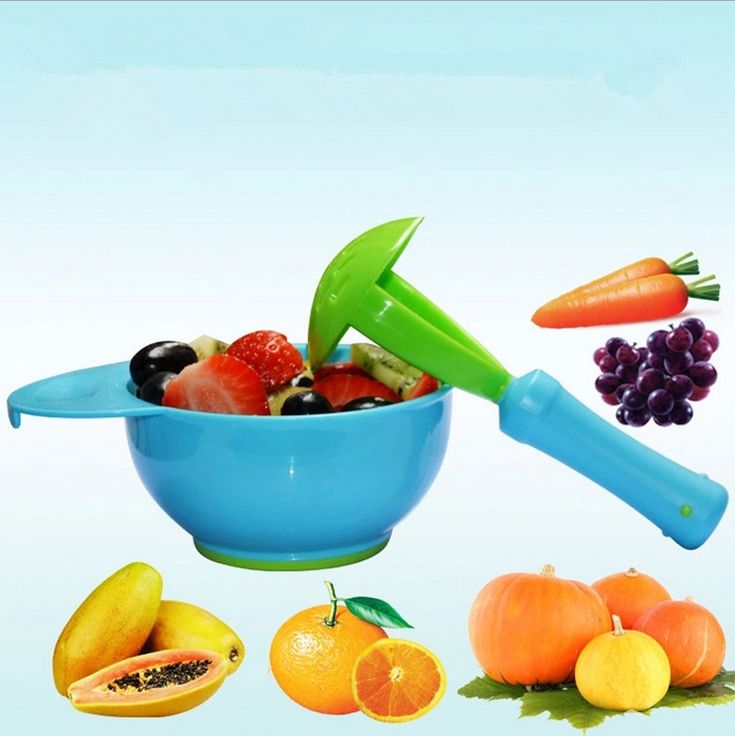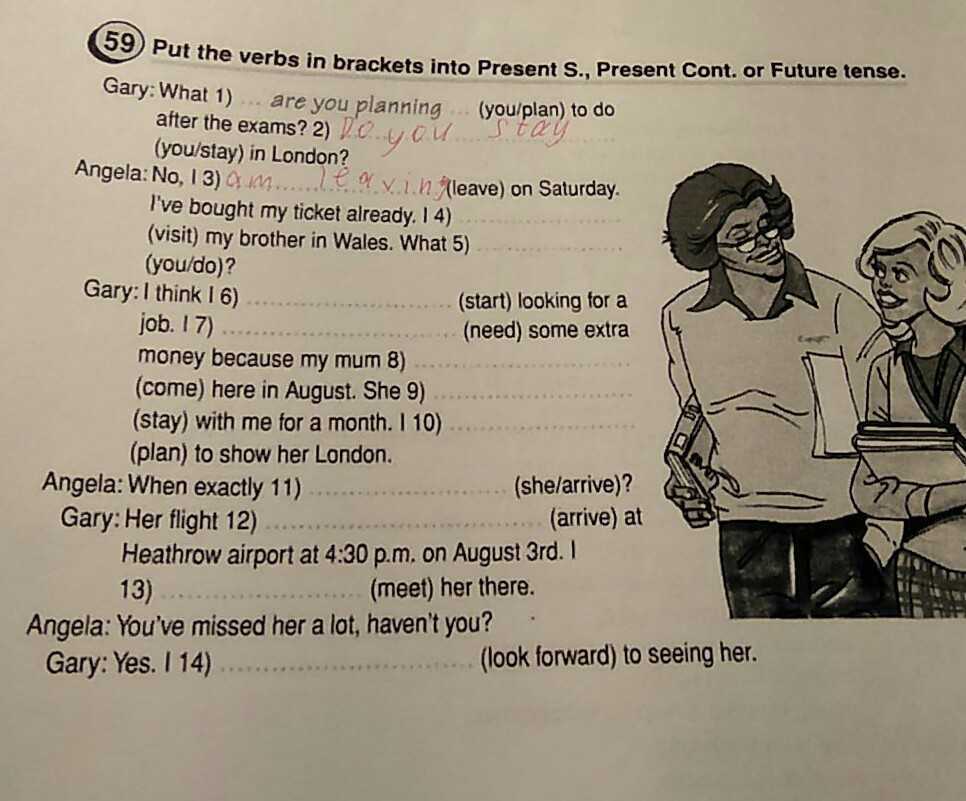Best way to bottle feed a breastfed baby
Introducing a Bottle to a Breastfed Baby
The information in this post is also contained in our Working & Breastfeeding.
Here is one approach to beginning pumping and introducing bottles that has worked well for many mothers as they prepared to return to work:
- Once breastfeeding is well established – usually after about four weeks – begin pumping after one feeding a day where your breasts still feel a little full. Remember you are pumping “leftovers” and should only expect a small amount.
- Freeze that first pumping immediately. You can add other pumpings to it after they have been cooled in the freezer.
- Your pediatrician may have given you a total number of ounces your baby may feed in a day or a range from the smallest probable amount to the largest, based on your baby’s weight.
- If dealing with a total volume over a 24-hour period, divide that by the typical number of times your baby feeds for a target volume for the first bottle.
- If dealing with a range, store volumes of the lower amount.
- Store some extra small volumes in case baby is hungrier than expected.
- When you have enough stored to equal the expected volume and a bit more, you can begin to plan a time to introduce a bottle.
- EXAMPLE for offering the first bottle:
- Your pediatrician suggests that your baby probably takes about 24 ounces a day.
- You know that he feeds between eight and 12 times a day.
- That means he could take anywhere from 2 to 3 ounces.
- You pump until you have a 2-ounce bottle and then have several 1/2 ounce bottles to equal at least three ounces or more saved.
- Choose a day that your primary support person will be available and a feeding time where baby tends to be more pleasant and patient for his feeding.
- Baby may accept a bottle more easily from someone other than you. He knows milk comes from you and may not understand why he’s not going there instead of to this foreign object.

- Thaw out the 2-ounce bottle in the refrigerator overnight.
- When baby begins to stir, place the bottle from the refrigerator in a bowl of warm water (bath temperature) or a bottle warmer while the person offering the bottle goes to get baby from his bed, changed and ready for the feeding.
- Often it helps to run the bottle nipple under warm water, if it was also in the refrigerator, to make it more acceptable to the baby.
- Baby should be held in an upright, almost sitting, position that is similar to the position usually used by the support person.
- The warmed bottle should be held at an angle tilted just enough to fill the nipple to allow baby to keep control of when and how fast the milk comes.
- Tickle the baby’s mouth to encourage an open mouth then bring baby up onto the bottle nipple, aiming the nipple toward the palate.
- Some have found that it can help to have an article of clothing you have worn, like a nightgown or t-shirt, to place on their arm, shoulder, or chest where the baby can smell your scent.

- It is usually best if you are close but not present in the room during this first “experiment” with bottle feeding. Your baby is very wise and will wait for you to come feed her if she knows you are nearby.
- If dealing with a total volume over a 24-hour period, divide that by the typical number of times your baby feeds for a target volume for the first bottle.
Once the feeding is completed, you will pump to create a bottle equal to what the baby consumed. Remember that the baby is always better than a pump! If you do not pump as much as the baby took, it is more likely a pump issue than an issue of not enough milk. Just pump after another breastfeeding and add that amount to what you pumped to get the amount baby took.
You will continue this pattern until you have enough milk stored in your freezer to get you through a normal work day plus a few extra for any hectic day at work where you may not have been able to pump as often. Plan to fully breastfeed for all feedings when not separated from your baby.
Working and Breastfeeding
Feeding Breastmilk From a Bottle
Pumping
Cleaning and Sanitizing Pumping Accessories
Hand Expressing
Published August 2018.
Tips to Bottle Feed a Breastfed Baby
A bottle teat is not the same as a breast despite claims by the manufacturers. Breastfeeding uses a different tongue and jaw action to that needed to get milk from a bottle, and skin is not the same as silicone. Sometimes a breastfed baby may begin to fuss at the breast in preference for the faster flow of milk from the bottle (bottle preference). And some babies find it hard to switch between bottle and breast. Some babies may start using a bottle feeding suck on the breast—leading to discomfort for you and frustration for your baby (nipple confusion). This article shares ideas that may help to reduce bottle preference or nipple confusion if you need to bottle feed a breastfed baby.
#1 Recreate a deep latch
The way a baby attaches to the breast is often called the “latch”. In a comfortable or deep latch, a baby will attach to the breast with a big mouthful of breast tissue as well as the nipple so that the nipple is deep in their mouth. Recreating the wide-mouthed jaw position seen with breastfeeding is thought to help prevent nipple confusion or nipple preference. To recreate this with a bottle try:
Recreating the wide-mouthed jaw position seen with breastfeeding is thought to help prevent nipple confusion or nipple preference. To recreate this with a bottle try:
A short or medium length teat with a medium sized base
A short or medium length bottle teat with a rounded tip and a medium-wide base can allow a baby to take most of the bottle teat in his mouth close to the screw cap. This will give him a wide open mouth around the base of the bottle teat and the tip of the teat will be deep in his mouth in the same position as the nipple during breastfeeding. The photographs below from Latching Tips show the kind of wide open mouth you can try and recreate on the base of a bottle teat.
Wide mouth, bottom lip turned out Bottom lip turned outArtificial nipples with a long narrow teat and/or a very wide base may force your baby to make a small mouth around the narrow length of the nipple similar to the mouth position when sucking on a straw. This could create bad habits with your baby’s latch when they breastfeed.
This could create bad habits with your baby’s latch when they breastfeed.
Trial and error
Be aware that the branding of bottles is not very reliable. Claims that one is closer to breastfeeding than another can usually be disregarded. Look for a bottle teat that suits your baby. You may need to try a few different teat shapes to see which works best to prop your baby’s mouth wide open with the bottle teat deep in his mouth. See Best Bottle for a Breastfed Baby? for more information about shapes and characteristics of teats that can support or undermine breastfeeding.
#2 Encourage rooting and gaping
Encouraging the rooting reflex and waiting for a wide gape before your baby takes the bottle teat in his mouth replicates how a baby takes a big mouth full of breast (not just the nipple). Brushing your baby’s lips gently with the tip of the bottle nipple will trigger his reflex to open his mouth to search for the nipple. When he opens his mouth at its widest point, offer the teat and encourage your baby to take the entire artificial nipple into his mouth close to the cap. If the bottle nipple is too long for your baby’s mouth, this could make him gag, so be guided by your baby and choose a shorter teat if needed.
If the bottle nipple is too long for your baby’s mouth, this could make him gag, so be guided by your baby and choose a shorter teat if needed.
#3 Switch sides
Breastfeeding usually involves switching breasts either part way through a feed or at the next feed. To replicate this you could hold your baby in the opposite arm to have the second half of their bottle or turn him on to his other side if he is side-lying (see below). This can help to maintain a baby’s willingness to feed in all directions at the breast and may be beneficial for normal eye development.
#4 Mimic the first let-down
At the breast your baby usually has to wait a minute or two for the milk ejection reflex or “let-down” to trigger plentiful flowing milk. Holding the bottle horizontally so milk doesn’t fill the teat for the first few sucks copies the waiting time before the let-down.
#5 Slower milk flow
Bottle teats can often provide milk faster than a breast which some babies may like—and can lead to babies preferring the bottle over the breast. If the flow is very fast however, it can also be stressful for your baby to try and keep up with the fast flow (see the stress cues discussed in #6 below). There are several ways to help avoid either bottle preference or distress from a fast flow:
If the flow is very fast however, it can also be stressful for your baby to try and keep up with the fast flow (see the stress cues discussed in #6 below). There are several ways to help avoid either bottle preference or distress from a fast flow:
Slow-flow teats
Slow-flow bottle teats will usually be closer to the rate of milk flow during breastfeeding. However, be aware that the claims and branding around bottle nipples can mean very little. A teat may be marked as slow flow but be very fast and vice versa1. The rate that milk drips from the teat when the bottle is held vertical is also not a reliable guide to the rate of flow when baby sucks. Avoid a teat that delivers milk so quickly that it causes your baby to be overwhelmed causing him to gulp, choke, spill lots of milk or show other more subtle signs of stress.
Baby’s body position
Milk automatically drips from most bottles when they are held upside down (vertically). A baby can’t control the milk flow from a bottle if he is lying flat on his back and milk is dripping down into his mouth even when he doesn’t suck. If a baby is on his back he will have to keep swallowing to keep up with the milk flow until the bottle is finished. This could be one of the reasons bottle feeding is linked with over feeding and obesity 2 and it can be stressful for the baby. Upright positions and side-lying positions can be helpful.
A baby can’t control the milk flow from a bottle if he is lying flat on his back and milk is dripping down into his mouth even when he doesn’t suck. If a baby is on his back he will have to keep swallowing to keep up with the milk flow until the bottle is finished. This could be one of the reasons bottle feeding is linked with over feeding and obesity 2 and it can be stressful for the baby. Upright positions and side-lying positions can be helpful.
Upright positions. Holding a baby so that they are either supported at a 45° angle or in more of an upright position can help them to control the flow of milk into their mouth.
Side-lying. A side-lying position can work well for a younger baby (see video below). The carer can tilt the bottle just enough to keep the artificial nipple filled with milk. As the bottle empties, take care not to hyperextend the baby’s neck and check for signs that the flow of milk is not uncomfortably fast for him.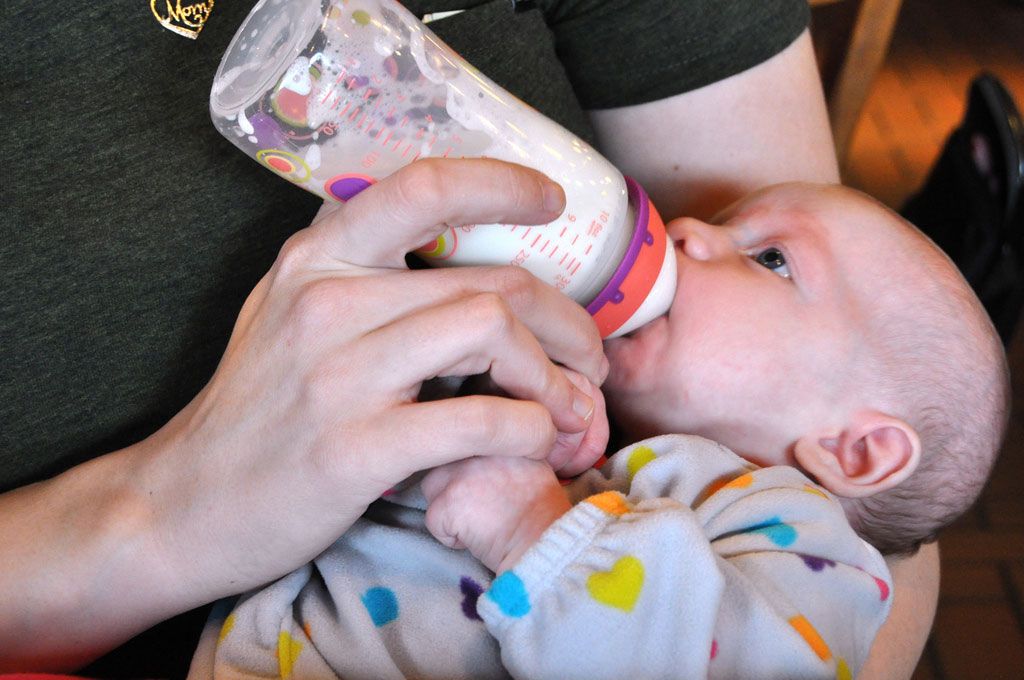
Bottle feeding a baby in a side-lying position:
Pace the feed, allow pauses
During breastfeeding, babies are in control of milk flow after the initial let-down; when they stop sucking, milk will stop flowing. It is not so easy for a bottle-fed baby to pause, take a break or decide that he is full if milk is dripping quickly from the bottle of its own accord. When the bottle is more horizontal a baby will have to suck more actively because gravity won’t be helping to pour milk into his mouth. By changing the angle of the bottle at intervals, a baby can take pauses when he needs them, rather than having a continual stream of milk from start to finish. Controlling milk flow in this way is often referred to as “paced feeding” or “pacing the feed”.34 Paced feeding can help a baby recognise when he is becoming full and prevents overfeeding (see video clip below).
Video clip showing how to pace a bottle feed:
#6 Watch baby for signs of stress
Not too fast
If the flow of milk is too fast, a baby may show signs they are stressed and the ideas in #5 above can be used to slow the flow. Signs of stress can be very subtle: for example frowning, looking wide-eyed or holding hands up with splayed fingers. Other indicators such as gulping, not pausing to take a breath, or becoming cyanosed (blue in colour) can also indicate milk may be flowing too quickly.
Not too slow
There is no need to slow the flow down unnecessarily so that your baby is frustrated— the pace can be “baby-led”. In particular, slowing the flow unduly is not appropriate for underweight babies with growth faltering who may need encouragement to feed in the easiest way possible.
Help! My baby prefers the bottle
The tips above can help to reduce or avoid breastfeeding problems but sometimes you may find that your baby still starts fussing at the breast and seems to prefer a bottle.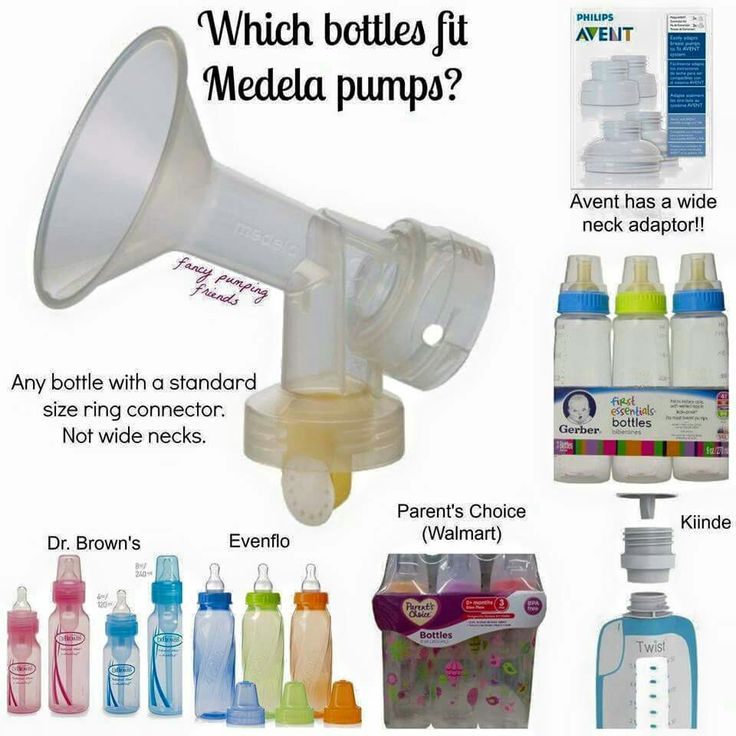 Or you may begin to notice changes to your baby’s latch when you breastfeed. If your baby is fussy at the breast or refusing to breastfeed you could try:
Or you may begin to notice changes to your baby’s latch when you breastfeed. If your baby is fussy at the breast or refusing to breastfeed you could try:
- Cutting back on using a bottle for a while to get breastfeeding back on track and see the ideas in How to Get Baby Back to the Breast
- Breast compressions to increase the flow of breast milk if they are frustrated with a slower flow at the breast
- If you are using a bottle to top up your baby due to low weight gain, and they are starting to fuss at the breast The “Finish at the Breast” Method of Supplementation described by Diana West and Lisa Marasco may be useful.5 This involves returning your baby to the breast to finish off their feed after having their top up. They then associate the breast with feeling full and may have more patience for a slower flow. Once your baby is gaining well and is stronger he may be able to take his supplement with a supplemental nursing system at the breast.

My baby has nipple confusion
If your baby’s latch seems to be affected despite trying the ideas above, cutting back on bottles for a while can help to reinforce your baby’s breastfeeding skills and review the principles of good attachment in Latching Tips. Alternatives to bottle feeding such as cup feeding or using a supplemental nursing system at breast or via finger-feeding can be discussed with your health professional and lactation consultant if bottles are interfering with breastfeeding.
Summary
Although some babies will happily switch between breast and bottle without any problems, bottle feeding can undermine breastfeeding if using a bottle changes the way a baby breastfeeds or if a baby begins to prefer a bottle due to a faster flow of milk. There are lots of ways to try to make a bottle feed more like a breastfeed and reduce bottle preference or nipple confusion. Cup feeding or breastfeeding with a supplemental nursing system can be alternative options to consider for supplementing a baby.
How to properly bottle feed
Feeding your baby is not only an important process for healthy growth and development, but also a way to establish close emotional contact with the baby and build trusting and loving relationships. The transition from breastfeeding to bottle feeding should be carried out after the mother and the child are fully prepared for this. We are talking about both the moral aspect, and about choosing the right bottle and getting adults the necessary skills so that eating brings only positive emotions and benefits to the baby. In this article, we will talk more about how to properly bottle feed your baby and where to start. nine0003
How to prepare your baby for bottle feeding
If this method of feeding is a completely new experience for the baby, or if parents decide to bottle feed their baby from a very young age, slow flow nipples should be preferred. So you protect the child from the possibility of choking while eating. Over time, you can gradually switch to bottles with nipples, which would provide faster and more intense feeding.
Feeding bottle selection and daily care
All baby accessories should be kept clean and sterilized regularly and thoroughly.
There are several ways to sterilize dishes:
- select the appropriate mode when using the dishwasher;
- or place the bottle and teat in a vessel of boiling water for 5 minutes.
Before using this method of cleaning the bottle, make sure that the material it is made of can be exposed to high temperatures. Since some types of plastic contain various chemicals in their composition, after sterilization they can become dangerous for their little user. For this reason, experts recommend choosing glass bottles. nine0003
The need for thorough cleansing of everything that the baby will touch is caused by the fact that in the first months of life, the child's immune system is just beginning to strengthen. Before sterilizing the teat, it can be cleaned with dishwashing detergent. There are special products for washing children's dishes, without a strong odor and with a safe composition.
How to bottle feed your baby
Before starting a meal, mom or dad should wash their hands well with soap and warm running water. Particular attention should be paid to the area between the fingers and under the nails. The hand washing process should take at least 20 seconds. And after carrying out this hygienic procedure, hands should be wiped dry with a paper towel or clean towel. nine0003
The next step is to prepare for the meal. If you plan to fill the bottle with formula, then dilute it with water in accordance with the instructions in the instructions. Improper proportions can lead to dehydration or bloating. It should also be remembered that for the preparation of the mixture you need to use only clean drinking water.
Breast milk is the most beneficial for a newborn. Despite this, pediatricians advise breastfeeding babies for as long as possible. Even if the mother is ready to give up breastfeeding, milk can be expressed into a bottle and gradually accustom the baby to the nipple. If, for one reason or another, the mother does not have the opportunity to feed herself, then the only alternative is feeding with a special mixture. nine0003
If, for one reason or another, the mother does not have the opportunity to feed herself, then the only alternative is feeding with a special mixture. nine0003
In the first six months after birth, cow's or goat's milk or its substitute in the form of soy milk should not be included in the baby's diet. Valid options for supporting healthy development of a newborn are breast milk or formula milk only.
What temperature should the bottle filler be? Under no circumstances should the bottle be heated on the stove or in the microwave. If the temperature of the bottle and its filling exceed 37°C, the baby may be burned. It is recommended to use special bottle warmers. If this is not possible, then use the following method:
- put a saucepan on the stove with a little water;
- bring the water to a boil, then remove the pan from the heat;
- place a bottle of milk in a vessel and heat it up to 37◦С;
- check the temperature with a pre-cleaned thermometer or a special device for measuring the temperature of foodstuffs.

You can also check the temperature of the ready-to-use bottle as follows:
- turn the bottle over;
- drip several times into your wrist area.
In this way, you can check not only the temperature of the milk or formula, but also how well the liquid flows out of the bottle. If you have to shake or squeeze the bottle hard to drip, the nipple is blocked and needs to be cleaned out. If, on the contrary, the filler pours out when the bottle is turned over, this means that the nipple is damaged and another nipple should be used to feed the baby, having previously sterilized it. nine0003
How to bottle feed your baby lying down
There are several techniques for feeding your baby. However, it is the feeding of the child lying down from the bottle that young parents consider the most comfortable. It is worth noting that eating in this position will only be safe when the baby's head is slightly raised. Otherwise, the child may simply choke. In the prone position, the child should be placed on his arm bent at the elbow. After feeding, you should place the baby in an upright position, taking him in your arms and putting his stomach to your chest. nine0003
In the prone position, the child should be placed on his arm bent at the elbow. After feeding, you should place the baby in an upright position, taking him in your arms and putting his stomach to your chest. nine0003
Make sure that the feeding bottle is closed correctly: the ring at the connection of the nipple to the bottle must not be too tight. Air must enter the bottle, otherwise a vacuum will be created there, which, in turn, will complicate the consumption of food for the child.
How to bottle feed without spitting up
Since the newborn is not able to fully control the process of feeding, along with milk, he can also take in air. This may be the reason that at one meal the child could not master the planned portion. In view of this, it is recommended to take small breaks during feeding. nine0003
As soon as you notice that the baby has stopped sucking on the pacifier, is tired or thoughtful, pick him up and press his face to you, holding his head and back. To help burp excess air, you can make a light massage between the shoulder blades, pat on the back or pope.
To help burp excess air, you can make a light massage between the shoulder blades, pat on the back or pope.
The air will quickly rise up and the baby will burp it without any extra effort. However, you should be prepared for the fact that, along with the air, part of the consumed mixture or milk may also return. Therefore, before taking the baby in your arms, cover yourself with a diaper, because it will be easier to wash it than clothes. nine0003
Never leave your baby alone with the bottle or let him fall asleep while using it. After eating, mom or dad must help their child burp. This will help to avoid colic, bloating and other manifestations of stomach discomfort.
Where to buy baby accessories
It's safe to say that I Love Mommy online store is one of the best places to buy baby food. Our catalogs feature products from world-famous brands, the quality of which you will not have to doubt for a minute. Bottles, baby dishes, pacifiers, baby bibs - all this and much more you can buy for your son or daughter from us at affordable prices in just a few minutes. nine0003
nine0003
How to bottle feed your baby
There is no better food for a newborn baby than breast milk. But sometimes breastfeeding is contraindicated for the mother.
Website editor
Tags:
Children
newborns
Philips
There is no better food for a newborn baby than breast milk. But sometimes breastfeeding is contraindicated for the mother. nine0003
Do not self-medicate! In our articles, we collect the latest scientific data and the opinions of authoritative health experts. But remember: only a doctor can diagnose and prescribe treatment.
Mother's milk has an optimal composition, it contains substances that help the baby fight infections and strengthen his immunity.
However, unfortunately, there are often situations in which it is impossible to continue breastfeeding: nine0109
- mother's illness when she has to take medicines that affect the quality of breast milk;
- mother's going to work;
- lack of breast milk.
Depending on the situation, breast milk can be expressed and bottle fed to the baby; transfer the baby to artificial feeding; alternate breast milk feeding with bottle feeding. In each of these cases, the mother is faced with the question of how to feed the baby from a bottle. nine0003
Bottle feeding technique
To ensure that the baby does not experience discomfort during bottle feeding, some basic rules must be observed:
ADVERTISING - CONTINUED BELOW
- Try to give your baby warm milk or formula - most babies prefer to be fed warm. To check the temperature of the mixture, drop it on the inner surface of your wrist - the feeling should be comfortable. nine0003
- If you are formula feeding your baby, be sure to check the expiration date on the box and carefully follow the instructions for preparation.
- For bottle feeding, choose a position that is comfortable for both you and your baby.
- The pacifier should be pressed lightly against the baby's lower lip so that he opens his mouth wide enough. Make sure that the tongue is located below, under the nipple. If the baby's lips close around the wide part of the nipple, closer to the base, it means that he took the nipple correctly. nine0109
- Do not rush your child and do not force him to eat the whole portion: some children eat quickly, others slowly, and some like to eat with breaks. Be patient.
- Always hold the bottle in a tilted position: this helps the nipple fill with milk or formula, which means that the baby will not swallow air. Make sure that the nipple does not become clogged or flattened. If this happens, change the pacifier.
- After the child has eaten, pour out the rest of the mixture so as not to provoke a bacterial infection. nine0003
- After eating, lightly pat your baby on the back to help expel the swallowed air.
We hope this bottle feeding technique helps you and your baby.
Bottle selection
The first thing to consider is the material the bottle is made of. Glass bottles tend to be heavier than plastic bottles and break easily. But they have a longer service life, while plastic bottles can become cloudy or crack quite quickly. But you can’t do without a plastic bottle on a walk and when the baby begins to learn to hold it on his own. nine0003
Another important nuance - when choosing a bottle, be sure to pay attention to the presence of clear divisions that will help you determine the volume of breast milk or formula.
Most baby bottles from well-known manufacturers are equipped with anti-colic protection. They are equipped with various mechanisms that prevent air from entering the baby's stomach and thereby reduce the likelihood of colic.
Philips AVENT bottles have a unique one-piece valve in the nipple skirt that lets air in and prevents a vacuum. Such a valve is easy to clean and does not break, and due to the lack of vacuum, the baby can suck in his usual rhythm, which brings bottle feeding closer to breastfeeding.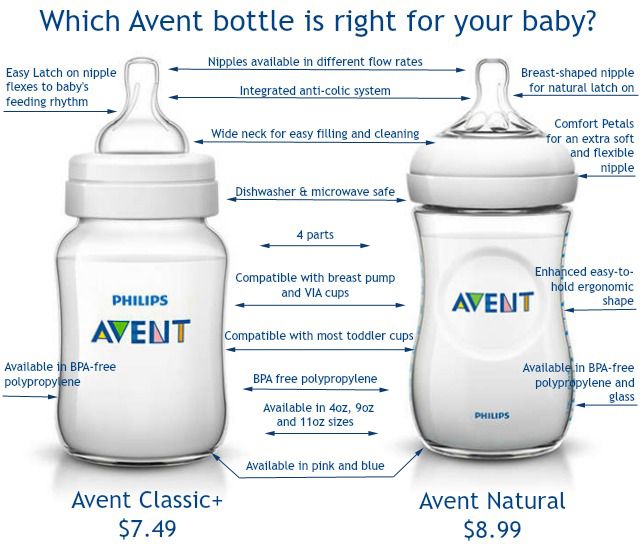 nine0109
nine0109
For bottles Dr. Browns has developed a special ventilation system that prevents the air entering the bottle from contacting the liquid. As the baby sucks and the liquid decreases, the bottle fills with air and no vacuum occurs.
The presence of a special valve in bottles Nuby also does not allow air to mix with formula or milk, thereby relieving the child of stomach cramps.
Just as important is choosing the right pacifier. Most nipples today are made from latex or silicone. Silicone teats are odorless, more durable and easy to disinfect. The second important point when choosing a nipple is the intensity of the flow. For the smallest, it is better to choose a nipple with one or two small holes, for an older child - with several holes. nine0003
Some manufacturers offer large-diameter nipples that mimic the shape of a woman's breasts to prevent breast rejection during mixed feeding.
Bottle and nipple care
If your baby is under a year old, it is important to practice good hygiene when bottle feeding. The immune system of young children is still weak enough to successfully resist all infections. If you do not pay enough attention to the handling of the bottle, pacifier and other feeding items, the baby may experience indigestion or diarrhea. nine0003
The immune system of young children is still weak enough to successfully resist all infections. If you do not pay enough attention to the handling of the bottle, pacifier and other feeding items, the baby may experience indigestion or diarrhea. nine0003
Wash items thoroughly with warm soapy water after each feeding and sterilize before the next feeding to remove all bacteria from the surface. For sterilization, it is best to use bottled or clean filtered water - this will help to avoid the appearance of plaque on the dishes. One of three sterilization methods can be used:
1. Boiling. Items that need to be sterilized should be placed in a saucepan, filled with water and placed on the stove. Boil 5 minutes. nine0003
2. Microwave processing. Place the items in a glass saucepan, fill with water, cover with a lid and put in the microwave for 5-8 minutes.
3. Treatment in a special sterilizer for bottles.
Advice from Leyla Namazova-Baranova, Doctor of Medical Sciences, Professor of MMA named after.




